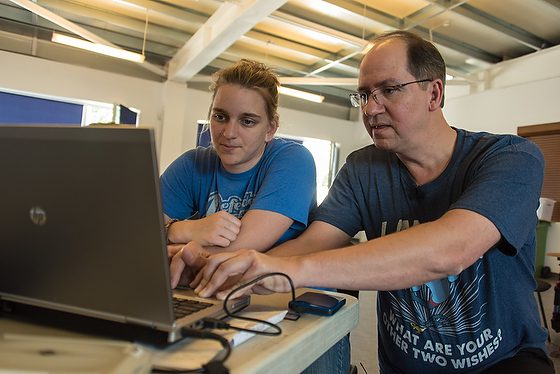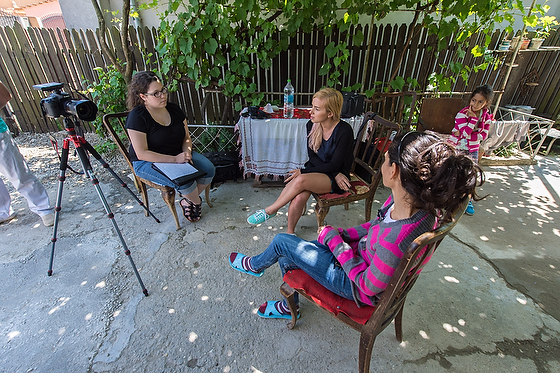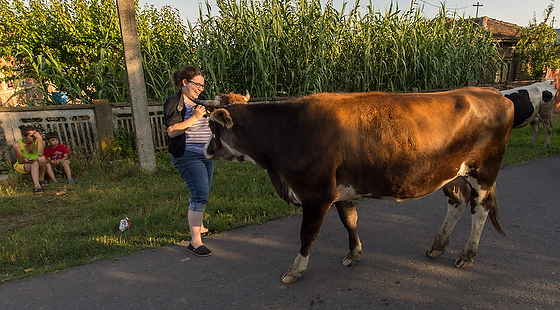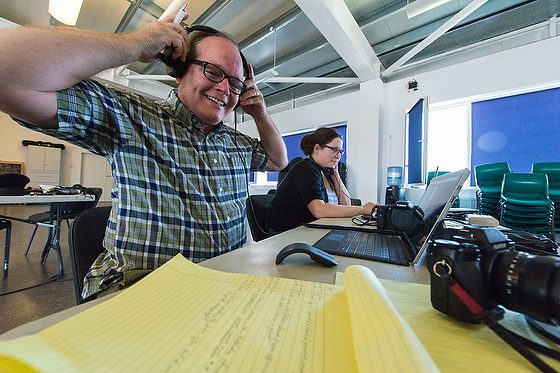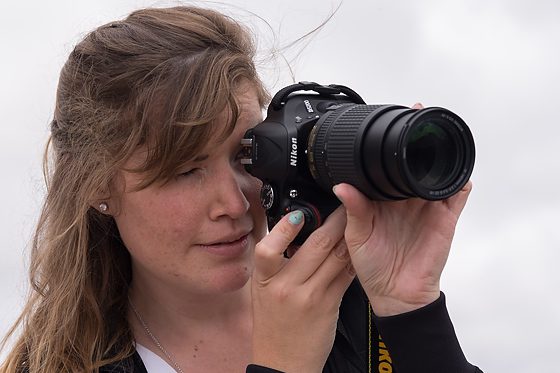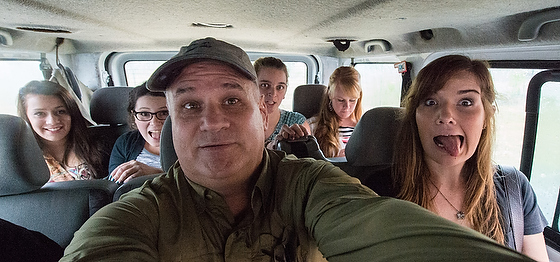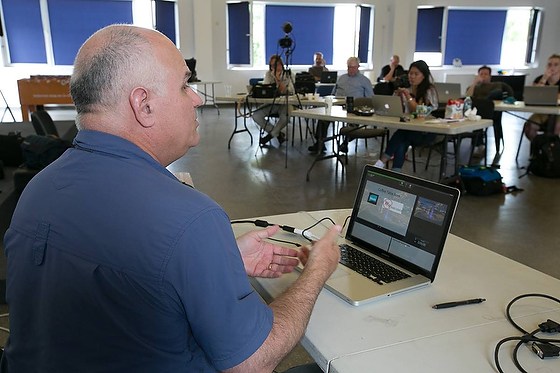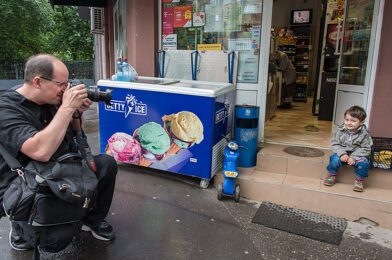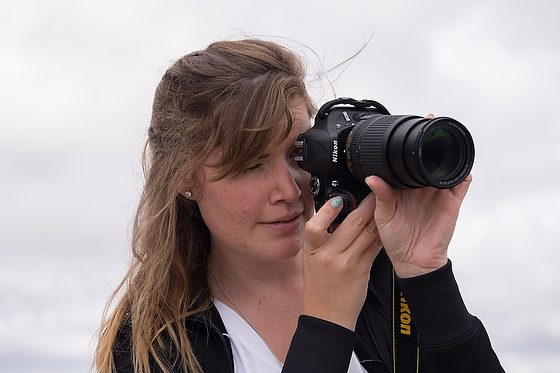| |
| James Dockery saw this little boy on the steps as we went to buy some water at this corner convenience store in Bucharest, Romania. After asking his mother if he could take a photo, I captured him and the boy. [Nikon D750, AF-S NIKKOR 28-300mm f/3.5-5.6G ED VR, ISO 1600, ƒ/7.1, 1/100] |
Take on more responsibility than just taking photos for your projects; this will improve your photography skills.
Today you can take on more responsibility with a project, whereas that just wasn’t possible in the past. In addition, you can easily be in control of the entire project from start to finish today due to the access we now have.
 |
| James Dockery works as a lead video editor for ESPN and also operates his own business in Charlotte, NC, where he is a photographer/ videographer. Here he is teaching the class about sliders and how they work. [Nikon D750, AF-S NIKKOR 28-300mm f/3.5-5.6G ED VR, ISO 1000, ƒ/4.5, 1/100] |
Due to computers becoming less intimidating and easier to use, barriers no longer exist. Before the Internet, you had to use print media, radio, or TV to reach your audience. Most of these mediums require you to gain the trust of those gatekeepers to use your content. Getting their faith took a lot of time, and you not only had to have outstanding work, but they had to like you.
In the past, you shot your images and handed these to someone like an editor, designer, or publisher, who would then take it from that point to reach the audience. Today you can find your audience and get them literally with just a few clicks.
 |
| Workshop participant Liz Ortiz interviewed a small village; and was her first interview, and was having to work with a translator as well. [Nikon D4, AF-S NIKKOR 14-24mm f/2.8G ED, ISO 1000, ƒ/5.6, 1/500] |
By creating your project, you can control the entire process. Today learning how to do this for yourself will improve your skills in any of these parts, like photography. I know from editing a project it is rare that I don’t realize I could have used more b-roll. Had I not been responsible for the entire project, I would not be the one yelling at myself to do a better job.
Nothing beats you holding yourself accountable.
Pictures alone do not tell a story. All these years as a photojournalist, the only way my photos communicated the story entirely was when accompanied by text or audio. If you wrote your own story, shot the images, and laid them out in a newspaper, it didn’t take long to see the holes you left while covering a story. Understanding the role of the producer would help you the next time to have a better checklist to be sure your account was even better than your last one.
 |
| On our last night in Bucharest, Romania, the workshop participants and hosts got together for a premier of the projects shot that week. While they are not the primary audience, they live there and see this firsthand; they are the ones that will use these stories to help tell their mission supporters back home what they are doing. [Nikon D750, AF-S NIKKOR 14-24mm f/2.8G ED, ISO 12800, ƒ/5.6, 1/25] |
The biggest mistake made today–forgetting your audience is not there.
We too often spend all our time with a subject and think this is our story. Instead, we need to take responsibility for the account connecting with the audience.
Why should the audience care? If you know your audience, you will not only be able to answer that question but also learn how to engage them; by the way, your cover the story. If the audience is kindergartners versus working professionals, they will have different interests in the take on the story.
Here is my advice. Take on a personal project that an audience will be interested in or should be interested in and do the story from start to finish.
Maybe help a local nonprofit tell its story and help them raise funds. The key here is not to say to the report, but be sure it is put on the web or in some printed piece and gets to the audience. Then you need to measure the success of your story. Did you help them raise more money than they did last year without your help?
 |
| Keziah Khoo, the workshop participant from Singapore, listens to James Dockery giving some editing tips in Adobe Premier Pro to help polish up her project. [Nikon D750, AF-S NIKKOR 28-300mm f/3.5-5.6G ED VR, ISO 12800, ƒ16, 1/50] |
In telling the story, you need to do it all. I recommend using multimedia. Multimedia is where you can interview subjects and capture them telling their stories. Use great b-roll to support their comments. Then put this on the web. Be sure you are promoting it as you are producing it.
When you take a photo of the subject on the first day, write a small paragraph and put it on social media. Then, tell people to stay tuned to see the whole story.
 |
| This photo is an example of a still image in that you would write a small paragraph about the lady and her community. Then you would say stay tuned and look for the story on your blog or YouTube feed, for example. [Nikon D750, AF-S NIKKOR 28-300mm f/3.5-5.6G ED VR, ISO 900, ƒ/5.6, 1/100] |
After you have taken on a project, you will start to see how all the pieces fit together. You will understand how to ask better questions in the future to help you do your role better when you are just part of the team and not doing it solo.
If you are used to just taking pictures of a story, will your photography suffer by doing it all? YES! However, will the project have more impact? YES!
I just got back from Romania, where the workshop participants I helped teach with James Dockery and Jeff Raymond for the first time did the entire project from start to finish.
Please take a look here at what Jon Franz did with his story. I know Jon’s work is helping because I didn’t just “LIKE” the package; I am “SHARING” it.
Does all this sound too intimidating? I recommend taking a multimedia workshop like the one I led in Bucharest, Romania, and last year in Lisbon, Portugal.
More than 80% to 90% of the time you are in the workshop, you produce the package. 10% to 20% is formal class time. James Dockery and I have discovered that getting people doing it hands-on works better than lecture. We then come alongside you and advise. We found that each workshop participant is different.
This approach lets the workshop participants draw upon our years of experience.
I am working on two workshops right now for next year. One will be in Roswell, Georgia, and one more in a foreign country. These will be 5 to 6-day workshops.
The workshop will match you with a local nonprofit to create a powerful photo story about their mission. We will have lectures, hands-on instruction, and business skills seminars throughout the week. Finally, we end with a public slideshow.
You will work directly with nonprofit staff and clients with an end project designed to be a call to action for the audience. You will have 1-on-1, personalized editing for each student happening every day. Our lectures will contain some of our work with storytelling, teaching storyline, how to interview subjects, getting that all-important b-roll, and how to put it all together using Adobe Premier Pro.
If you are interested, contact me at [email protected] so I can put you on the mailing list for more details.

